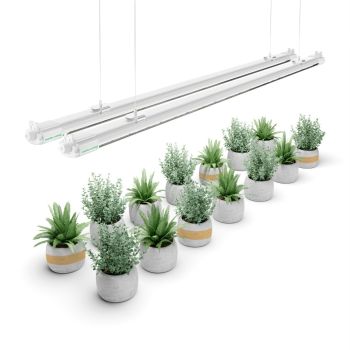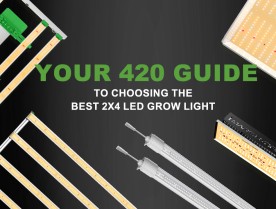
Ever pondered on the thought of creating your very own mushroom haven? With the right tools and guidance, you can set up a mushroom grow tent that ensures optimal growth and harvest. This article dives deep into the realm of mushroom cultivation, offering you tips on how to make a mushroom grow tent easily.
What Is Mushroom Grow Tent?
A mushroom grow tent is a specialized structure, akin to regular grow tents, tailored for the cultivation of mushrooms. Just like its counterpart for plants, it's designed to provide a controlled environment, optimizing conditions for growth. While the core features mirror those of standard grow tents, the mushroom version emphasizes conditions favorable for fungi, ensuring their prolific growth.
A mushroom grow tent offers an isolated environment, conducive for mushroom growth. It also provides the cultivator with the control to regulate conditions like humidity, light, and temperature – pivotal factors that influence mushroom growth. Be aware that all mushroom grow tents are not created equal. Some merely trap air and moisture, leading to a damp setting in which mushrooms cannot flourish. Meanwhile, others circulate excessive air, causing the mushrooms to dry out, or they don't effectively filter out spores or maintain an appropriate fresh air exchange. Let’s embark on a journey to understand how you can set up your very own mushroom grow tent.
How to Set Up a Mushroom Grow Tent?
Setting up a mushroom grow tent can seem like a lot at first glance, but with a little patience and the right guidance, it becomes a walk in the park.
Step-by-Step Instructions
1. Select a suitable location:The location should be away from direct sunlight and drafts. A basement or a spare room can be ideal.
2. Assemble tent frame:Build a frame from PVC pipes. Depending on your design, you might need to cut the pipes and connectors with a hand saw.
3. Cover the frame:Drape a plastic sheeting or mylar over the frame and secure it, ensuring there are no gaps or openings.
4. Install shelving:Depending on your tent size, you can have multiple tiers of shelves. Growing tents typically use plastic or metal shelving since wood can warp and decay in humid conditions.
5. Install an exhaust fan and a filter: Cut a hole on top of your tent for the exhaust fan. This helps remove CO2, as mushrooms produce CO2 and consume oxygen. Ensure the filter is positioned where fresh air enters the tent.
6. Install a humidifier: Place the humidifier inside or near the tent. If it's outside, you can duct the mist into the tent. Regularly mist the interior using the misting bottle to keep humidity levels high.
7. Install a hygrometer and thermometer: Place the hygrometer & thermometer inside the tent to monitor conditions. Aim for 90-95% humidity for most mushrooms during the fruiting stage and temperatures appropriate for your specific mushroom species.
8. Place the lights: Attach the LED lights to the ceiling pipes using zip ties or another suitable method for your setup.
9. Inspect your tent:Confirm that your grow tent functions correctly. Additionally, verify that it effectively blocks out light, the ventilation operates without causing negative pressure inside, and there's ample room for plant growth.
Once the tent is set up, you can introduce your mushroom bags or trays. Remember to always work with clean hands and tools to minimize contamination.
Easier Way to Create a Mushroom Grow Tent
That covers the materials and steps on how to set up a mushroom grow tent. If you find the process of collecting materials and setting the tent up on your own too cumbersome, consider purchasing a grow tent kits. It allows you to set up your tent at speed.
Advantages of Using a Pre-made Mushroom Grow Tent Kit

-
Quality: Crafted from robust 1680D canvas that resists tears, this tent boasts sturdy SBS zippers, reinforced seams, and a protective zipper flap. This combination ensures durability and longevity. Moreover, its zippers are resilient against wear, effectively keeping out spores, thereby preventing allergies or other issues from spore infiltration.
-
Waterproofing: The environment required for mushroom growth is very humid, which can lead to water accumulation inside the tent. To address this, the tent includes a detachable tray for easy removal and cleaning of excess water. Furthermore, the accompanying LED lights have a Waterproof IP65 rating, ensuring they operate efficiently in moist conditions.
-
Operational Convenience: Integration with an iHub power strip allows this tent to be controlled remotely via a dedicated app. Users can manage device settings, as well as monitor temperature and humidity, ensuring optimal conditions for mushroom growth.
-
Portability:This tent is designed for effortless assembly and disassembly, catering to those who might need to move their setup or have restricted space. In contrast, the DIY tent requires a certain level of expertise, potentially involving multiple trips to stores, and the risk of measurement errors or overlooking essential components.
-
Ease of Setup: With an intuitive design and accompanied by clear, comprehensive instructions, assembling this tent is a breeze, even for novices.
-
Cost Efficiency: It is more cost-effective as it comes with all the necessary components, eliminating the need to buy individual parts separately, which can be more expensive.
-
Longevity: Constructed from rigorously tested materials, this tent is made to withstand numerous growth cycles. Conversely, the durability of a DIY setup can fluctuate based on the materials used, which may not always be of the same caliber as those in pre-packaged kits.
-
Space Utilization: Available in a range of sizes, users can select a tent that best fits their spatial and cultivation needs. This adaptability ensures optimal space usage, particularly in city environments.
-
Water Management & Cleanup: The inclusion of a water-repellent and removable floor tray ensures containment of any spillages within the tent. This design minimizes potential water damage to adjacent areas and simplifies the cleaning process.
-
Support & Warranty: This tent comes backed with customer assistance and warranties, providing you with added confidence. On the other hand, DIY mushroom tents don't have the luxury of professional support or guarantees, leaving troubleshooting and rectifications up to you.
Final Thoughts
While there's no doubt that constructing your own tent can be a rewarding experience, the advantages of a pre-made mushroom grow tent kit are abundantly clear. From the assured quality of materials to ease of setup and operation, these kits simplify the mushroom cultivation process manifold. They bring to your doorstep the collective wisdom of experts and the convenience of a one-stop solution. Waterproofing, smart controls, portability, and cost efficiency are just a few of the multiple benefits these kits offer.
For those eager to dive into the world of mushroom cultivation without the hurdles of sourcing individual components, deciphering setup instructions from multiple sources, or being unsure of the efficacy of their DIY setup, a pre-made grow tent kit is the way to go.
Whether you opt for the DIY route or go with a pre-made kit, the ultimate goal is the same: creating a perfect environment for your mushrooms. As you embark on this journey, remember that the love, care, and attention you pour into your fungi will reflect in your harvest. By adhering to the setup and care recommendations in this guide, you're on the path to a fruitful mushroom yield. Happy growing!
FAQs
-
What is the ideal temperature for growing mushrooms in a mushroom grow tent?
The optimal temperature can vary based on the mushroom species. However, most mushrooms thrive at temperatures between 70°F to 75°F.
-
Do I need light to grow mushrooms in a mushroom grow tent?
Yes. Even though mushrooms don't require light for photosynthesis (like plants) they still require light to form fruiting bodies. Light does play a role in the mushroom growing process, particularly when it comes to triggering certain species to initiate fruiting (the development of the actual mushroom bodies we see) and guiding the direction of their growth.
-
How often should I check on my mushrooms?
Inspecting your mushrooms every day is recommended, particularly to assess elements such as humidity, temperature, and possible pest issues. However, with a Mars Hydro grow tent and its intelligent system designed to maintain ideal conditions, you can reduce the frequency of your checks.
-
Is it expensive to maintain a mushroom grow tent?
While there's an initial investment in setting up the tent and buying the necessary equipment, maintaining it isn't particularly expensive. Regular checks and minor adjustments are typically all that's needed.







